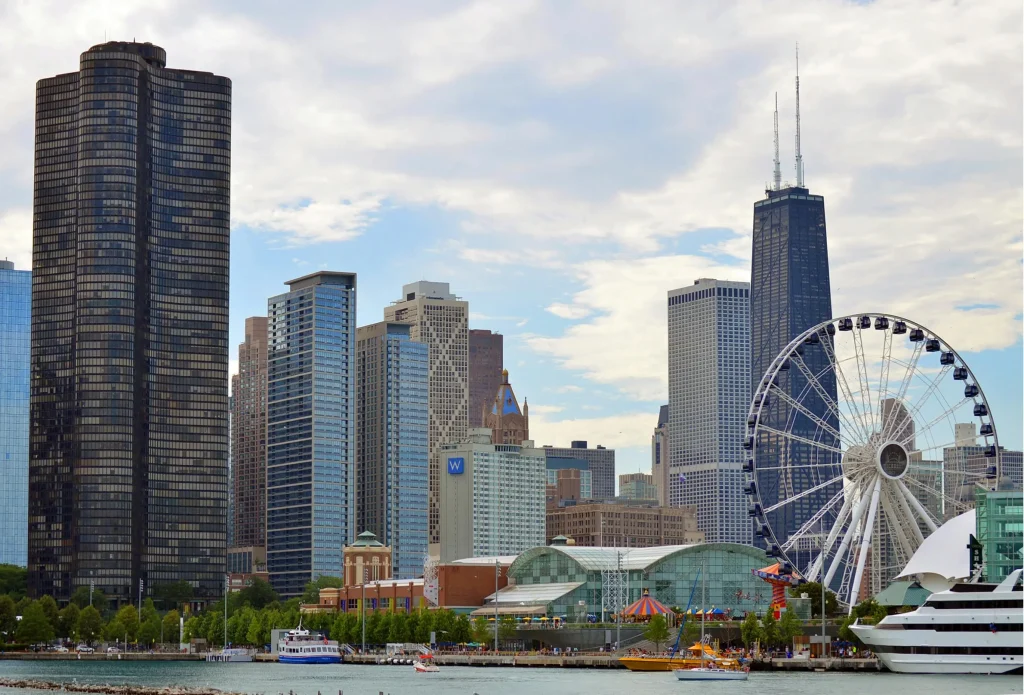Thinking about moving to the US for studies or work? It’s a big step, and the idea of living in one of the world’s most diverse and dynamic countries is exciting! From bustling cities like New York and Los Angeles to charming college towns, the US offers countless experiences.
But like any country, life in the US comes with its ups and downs. While you’ll enjoy world-class education, career opportunities, and cultural diversity, it’s also essential to consider factors like the cost of living and healthcare. To help you make an informed decision, let’s explore the pros and cons of living in the US — so you know exactly what to expect!
Table of Contents
Pros of Living in the USA

Whether it’s for studying, working, or simply exploring a new culture, the USA has a lot to offer. With its vast landscapes, cultural diversity, and countless opportunities, living in the USA can be a rewarding experience. From world-class universities to exciting career options, there’s something for everyone. Let’s explore some of the top pros of living in the USA.
1. World-Class Education
The USA is home to some of the best universities and colleges in the world. Institutions like Harvard, MIT, and Stanford consistently rank at the top globally. International students benefit from advanced research facilities, experienced faculty, and diverse academic programs. The opportunity to study in such a competitive environment can significantly boost your career prospects.
2. Diverse Cultural Experience
Living in the USA means immersing yourself in a melting pot of cultures. From bustling city life in New York to vibrant musical festivals in the USA, you’ll find people from all walks of life. You can experience different cuisines, traditions, and languages, making it a perfect destination for those seeking cultural enrichment.
3. Career Opportunities
The USA offers a wide range of career opportunities across various industries. Sectors like technology, healthcare, finance, and engineering are booming. With a strong economy and numerous multinational companies, finding a job that matches your skills and ambitions is achievable.
4. Access to Quality Healthcare
While healthcare costs in the USA can be high, the quality of medical services is among the best globally. Hospitals and medical centres are equipped with state-of-the-art technology and specialised doctors, ensuring excellent patient care. Health insurance plans can also make medical care more affordable.
5. Travel and Adventure
If you love to travel, the USA has it all. From the beaches of Florida to the mountains of Colorado, every state offers something unique. You can explore iconic landmarks like the Grand Canyon, Yellowstone National Park, and the Statue of Liberty. Road trips and weekend getaways are popular ways to enjoy the country’s diverse landscapes.
6. Technological Advancements
Living in the USA means being at the heart of innovation. Silicon Valley, located in California, is the global hub for technology companies like Apple, Google, and Meta. You’ll have access to the latest tech gadgets, applications, and services, keeping you connected and up to date.
7. Freedom and Rights
The USA values personal freedoms and civil rights. As a resident, you’ll experience a society that embraces freedom of speech, religion, and expression. The country’s legal framework protects individual rights, allowing you to live freely and pursue your dreams without unnecessary restrictions.
Also Read:
- Pros and Cons of Living in Birmingham for International Students
- Pros and Cons of Living in London, UK in 2025
Cons of Living in the USA

Living in the USA can be an exciting and rewarding experience, but like any other country, it has its downsides. As a student or a newcomer, adjusting to a new lifestyle can come with challenges. While the USA offers diverse opportunities and experiences, it’s important to be aware of some of the disadvantages you may face. Let’s explore some of the main cons of living in the USA.
1. High Healthcare Costs
Healthcare in the USA is notoriously expensive. Unlike many other countries that offer public healthcare, the USA primarily operates on a private healthcare system. Without adequate health insurance, even a minor medical procedure can cost thousands of dollars. International students are often required to purchase medical insurance, which can add to their living expenses.
2. Expensive Education
The USA is home to many prestigious universities, but higher education comes at a steep price. Tuition fees for international students can range from USD 20,000 to USD 50,000 per year, depending on the institution and program. Additionally, the cost of textbooks, accommodation, and other living expenses can further increase the financial burden.
3. Complicated Visa Process
The visa application process for the USA can be complex and time-consuming. Many students face challenges in obtaining their student visas (F-1 visas) due to strict regulations and extensive documentation requirements. Additionally, visa extensions and work permits come with their own set of challenges and uncertainties.
4. High Cost of Living
The cost of living in the USA can vary significantly depending on the city you choose. Major cities like New York, San Francisco, and Los Angeles are notoriously expensive. Rent, groceries, and transportation costs can quickly add up, making it difficult to manage expenses on a student’s budget.
5. Cultural Adjustment
Adapting to a new culture can be challenging, especially if it’s your first time living abroad. Differences in language, social norms, and customs can lead to culture shock. Many international students may experience homesickness and struggle to build a social circle initially.
6. Lack of Public Transportation
Unlike many European and Asian countries, the USA lacks extensive public transportation networks, especially in smaller cities and suburban areas. Owning a car becomes a necessity in many regions, adding to transportation expenses. While larger cities offer better transit options, they may still be costly.
7. Safety Concerns
While most areas in the USA are safe, some cities experience higher crime rates. Gun violence and mass shootings are ongoing concerns in certain regions. It is advisable to research the safety of your chosen city and follow precautions to ensure your personal safety.
Cost of Living in the USA for Students

Studying in the USA is a dream for many international students. While the country offers excellent academic opportunities, understanding the cost of living is essential to budget wisely. Your expenses will vary depending on the city, lifestyle, and housing choices. To give you an idea, here’s a breakdown of the average cost of living in the USA for students.
| Expense Category | Average Monthly Cost (USD) | Notes |
| Tuition Fees | USD 1,000 – USD 4,000 | Varies by university and course |
| Accommodation (Shared Apartment) | USD 500 – USD 1,500 | On-campus or off-campus options |
| Utilities (Electricity, Water) | USD 100 – USD 200 | Depends on city and usage |
| Internet and Mobile Plan | USD 50 – USD 100 | Mobile data and internet subscription |
| Groceries | USD 200 – USD 400 | Basic food and household supplies |
| Transportation | USD 70 – USD 150 | Public transport or ride-sharing |
| Health Insurance | USD 80 – USD 150 | Mandatory for international students |
| Entertainment and Leisure | USD 50 – USD 150 | Movies, dining out, and events |
| Personal Expenses | USD 100 – USD 300 | Clothing, personal care, etc. |
| Books and Study Materials | USD 50 – USD 100 | Academic textbooks and supplies |
Also Read:
- Pros and Cons of Self-Packing: Ultimate Guide for Your Study Abroad Journey
- What are HMOs? Know Full Form, Its Pros and Cons
Tips to Manage Challenges of Living in the USA
Living in the USA can be an exciting adventure, but it also comes with its own set of challenges. But don’t worry – with the right strategies, you can overcome these obstacles and make the most of your experience. Here are five practical tips to help you manage the challenges of living in the USA.
1. Create a Budget and Track Your Expenses
Managing your finances is crucial when living in a new country. Start by creating a monthly budget that covers essentials like rent, groceries, utilities, transportation, and other expenses. Knowing where your money goes will prevent overspending and ensure you stay within your budget. Additionally, look for student discounts and coupons to save money.
2. Build a Support Network
Feeling homesick or overwhelmed is common when adjusting to life in the USA. To cope with this, try building a strong support network. Connect with fellow international students, join student organizations, and participate in cultural events.
3. Improve Your Communication Skills
Language barriers can be challenging, especially if English is not your first language. To build confidence, practice speaking English in everyday situations. Attend language workshops, join conversation clubs, or find a language exchange partner. Don’t be afraid to make mistakes – every conversation is a learning opportunity.
4. Understand Cultural Differences
The USA is a diverse country with different customs and traditions. Take time to understand the cultural norms in your region. Observe how people interact, greet each other, and handle social situations. Being open-minded and respectful of cultural differences will help you adapt faster and make meaningful connections.
5. Manage Stress and Prioritize Self-Care
Adapting to a new environment can be stressful. It’s important to manage stress by practising self-care. Exercise regularly, eat nutritious meals, and get enough sleep. Many universities provide free counselling services, making it easier to access the support you need.
Living in the USA has both advantages and drawbacks. The key is to be prepared and informed. While you’ll experience a top-notch education and a vibrant lifestyle, challenges like the high cost of living and cultural adjustments are real. Weigh the pros and cons carefully to decide if studying in the USA is the right choice for you.
Hope you liked reading our blog about the pros and cons of living in the USA. For a stress-free stay during your study abroad adventure, choose Fly Homes. Call 1800572118 to reserve your ideal accommodation abroad with ease.
FAQs
The USA offers world-class universities, cultural diversity, and networking opportunities. However, high tuition fees, living costs, and cultural adjustments can be challenging.
It depends on the city and university. On-campus housing can be convenient but expensive. Off-campus apartments might be cheaper, especially when shared.
Boston, New York, and Los Angeles are popular but expensive. Affordable options can be found in cities like Austin, Denver, and Pittsburgh.
On-campus housing offers safety, proximity to classes, and easy access to campus facilities. It also helps students make friends and build a community.
It can be costly and may offer less privacy. Some universities may have limited availability, forcing students to look for off-campus housing.
On-campus is ideal for freshmen and those wanting convenience. Off-campus housing is often cheaper and offers more independence for senior students.
On-campus housing may cost USD 8,000 to USD 12,000 per year. Off-campus rentals can range from USD 500 to USD 1,500 per month, depending on the city.
Yes, students often choose shared apartments, university dorms, or homestays. Some universities also offer housing assistance for international students.
Consider the rent, location, safety, transportation, and proximity to your university. Utilities and internet costs should also be checked.
Yes, international students on an F-1 visa can work up to 20 hours per week on campus. Some off-campus jobs may also be allowed under specific conditions.
Follow Us on Social Media




























